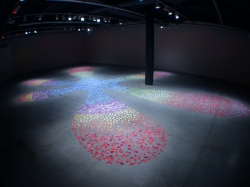
|
||
|
Portland art blog + news + exhibition reviews + galleries + contemporary northwest art
|
||
Ellen George at the Archer Gallery
The artists' signature is a contentious thing - it's the mark of authenticity and the mark of ego. It's also the thing that will irk not only your second generation postmodernist teachers at art school, but those of your classmates who know better, when you hand in your first crappy undergrad painting assignment with your own big red signature scrawled across the bottom. The last line of the artist's statement accompanying the exhibition at the Archer Gallery at Clark College in Vancouver reads, "I sign everything with an e*." We've seen Jacqueline Ehlis do a signature piece, a riff off of the slick paintings of customized cars. And at her latest exhibition, entitled *, Ellen George makes a signature piece with a sprawling, room-sized, cartoonish asterisk form, formed by several thousand polymer clay pieces shaped by hand. Teardrops, many-pronged stars and cloud-like blobs were carefully arranged, a gradation of rainbow colors radiating from the cool blue center to the striking red edges. The arrangement threatened to coalesce into a rigid pattern, but George retained vibrance in the piece by creating a loose and slightly irregular mosaic of shapes.
The individual pieces are the most abstract I've seen from George, who typically creates shapes that resemble spores, pods, tiny mushrooms or enlarged hair. I must admit I did miss the feeling of life forms that imbues her other work, lending it a disconcerting tension between naturalism and the artificiality of her material. The work in * were clearly dead, geometric entities. George eschewed the normal dialog present in her work between living/static, nature/artifice, high/low in favor of pure visual delight. The individual shapes were flat, cookie-cutter forms with clean edges, acting as very graphic two-dimensional objects, not unlike Polly Apfelbaum's complex floor pieces. And this time, George's use of polymer clay only accentuated the superficial nature of her materials. George's thorough attention to detail is what allows her to pull off this kind of work successfully. She carefully controlled the gallery space, creating temporary walls that allowed the installation to exist with minimal visual interruptions. She also paid very close attention to the lighting, creating a slightly darkened space, walls warmed with dim yellow and orange lights. The large asterisk was well-lit with bright white lighting, creating another layer of tension that made her installation work so beautifully. Attention to lighting also accentuated the ambiguity of this piece acting as a two-dimensional drawing and a three-dimensional sculpture, a key aspect of George's work that was carried over into this exhibition. Sunday marked the last day of the exhibition, but let's hope we don't have to wait too long before we get to see more or George's work at PDX's beautiful new space, which her work will look fantastic in. Posted by Katherine Bovee on October 24, 2005 at 8:46 | Comments (0) Comments Post a comment Thanks for signing in, . Now you can comment. (sign out)
(If you haven't left a comment here before, you may need to be approved by
the site owner before your comment will appear. Until then, it won't appear
on the entry. Thanks for waiting.)
|
| s p o n s o r s |
 |
 |
 |
 |
 |
 |
 |
 |
 |
 |
 |
 |
 |
 |

|
Site Design: Jennifer Armbrust | • | Site Development: Philippe Blanc & Katherine Bovee | |



